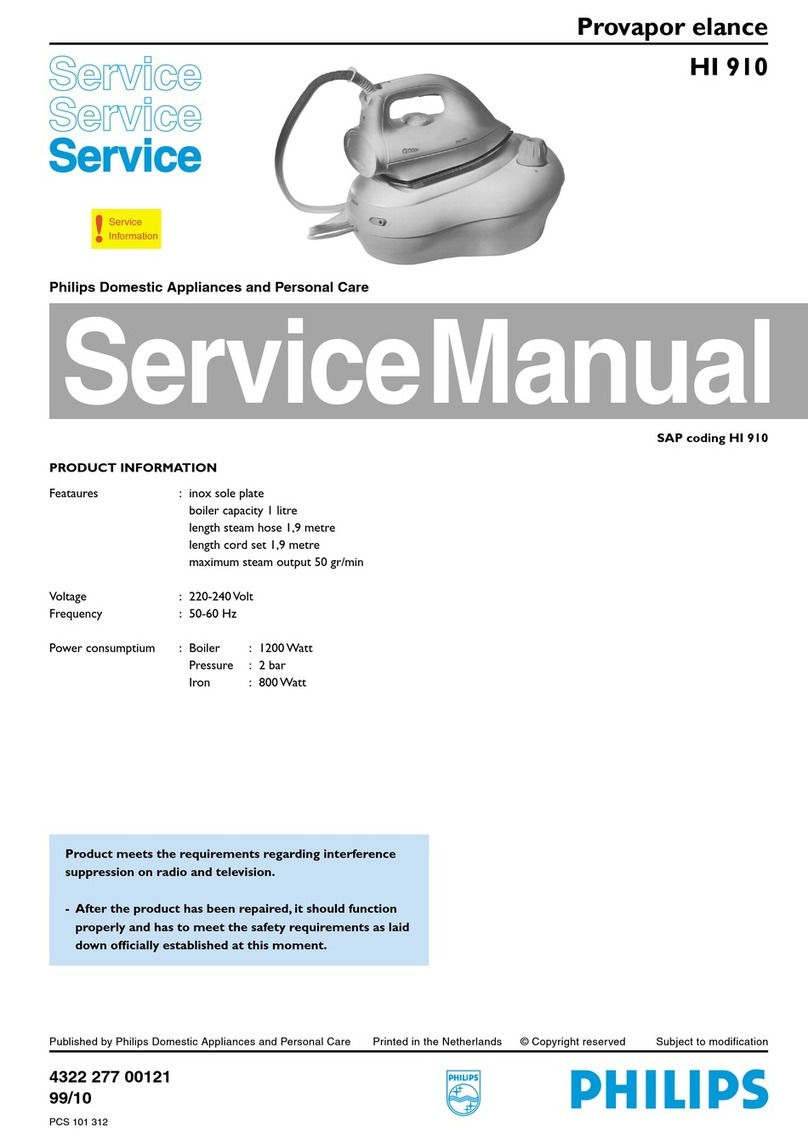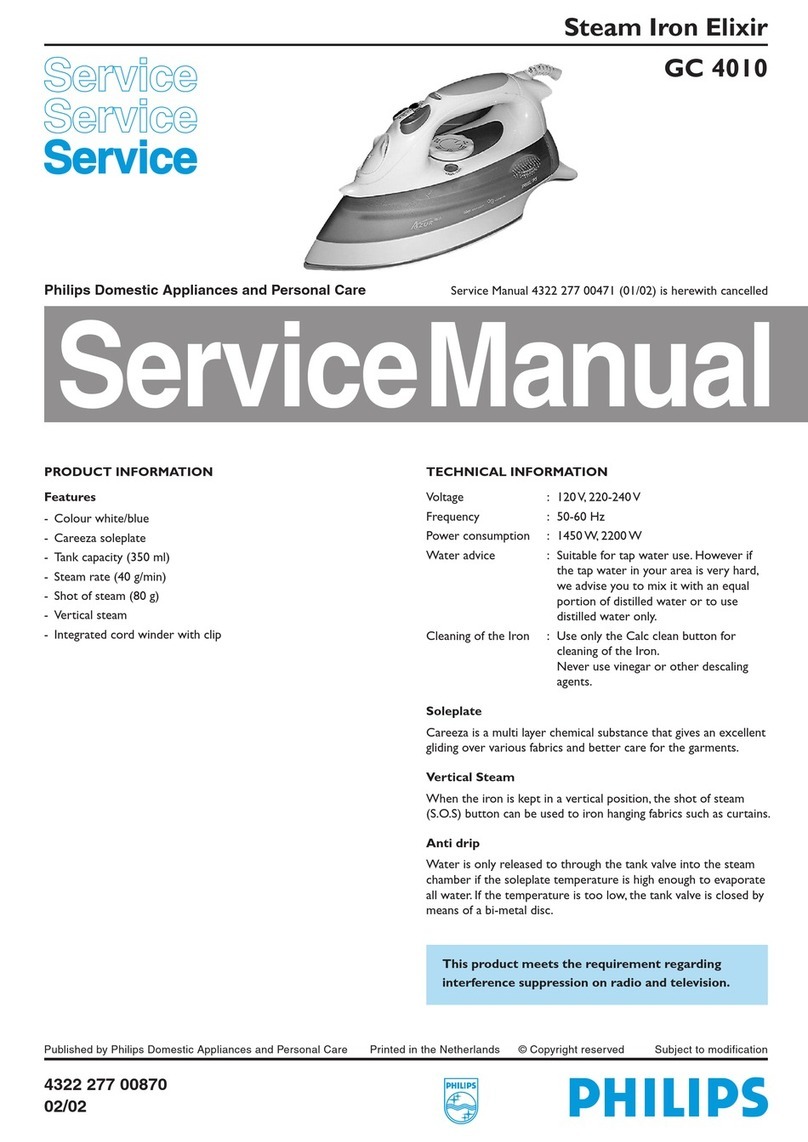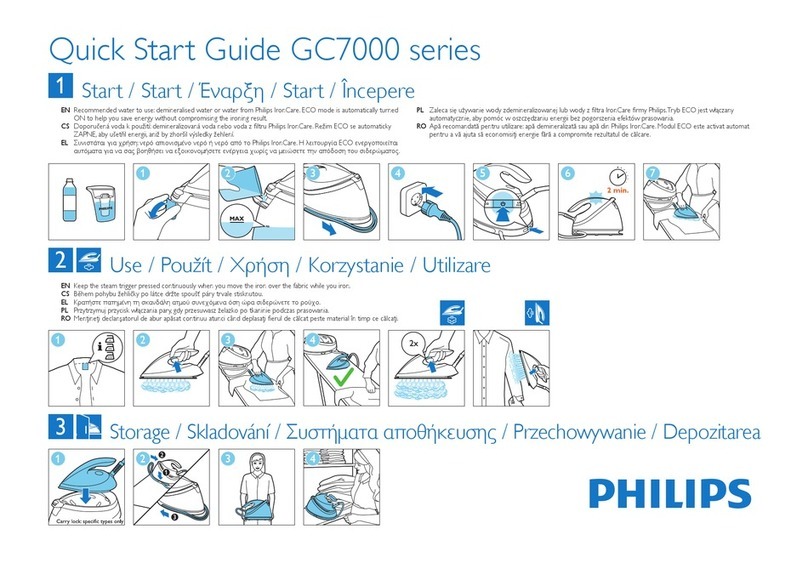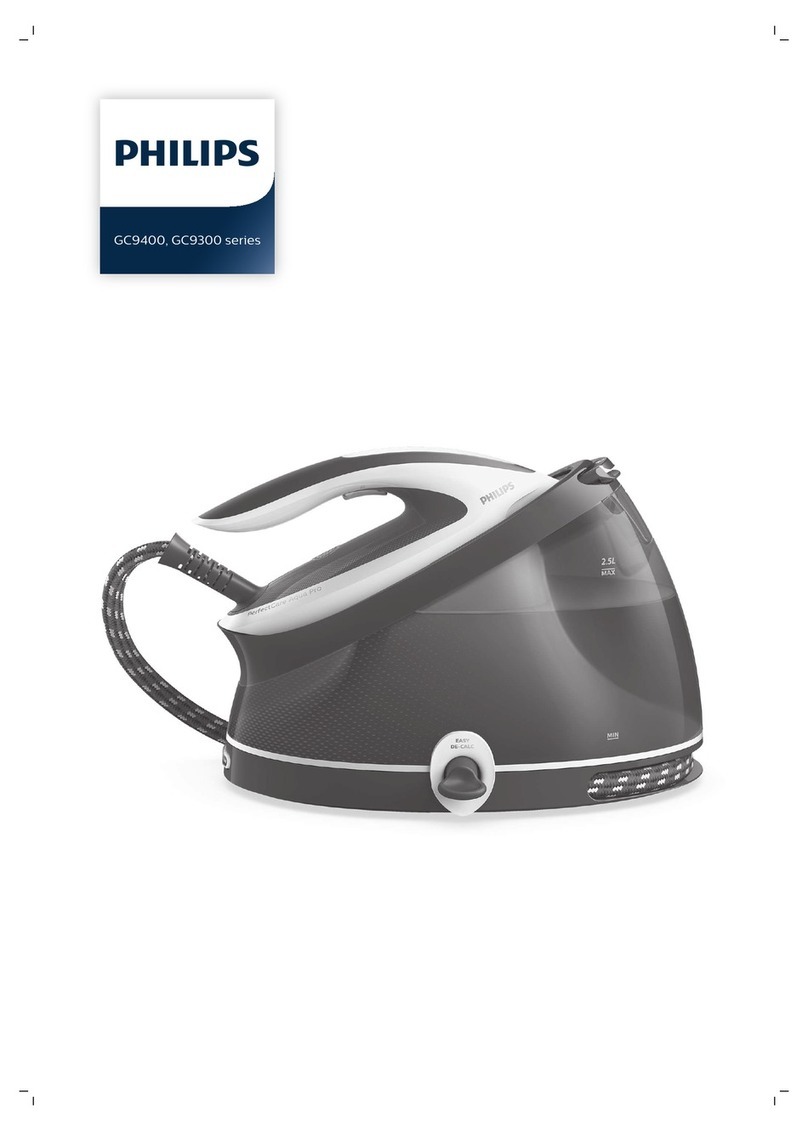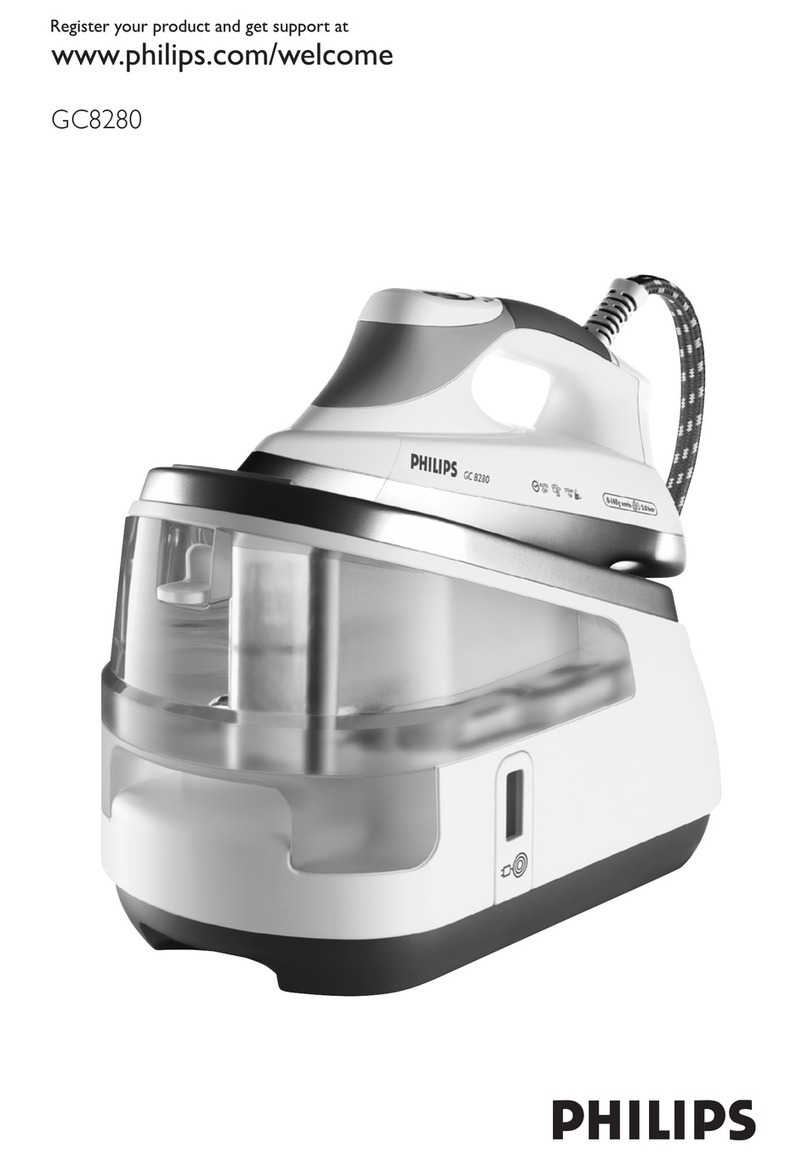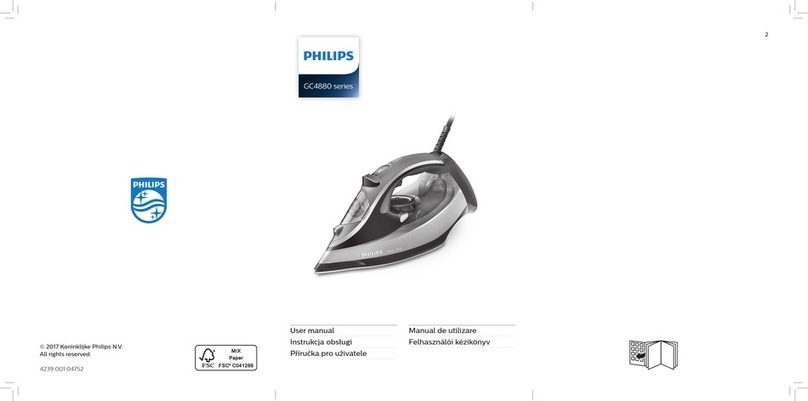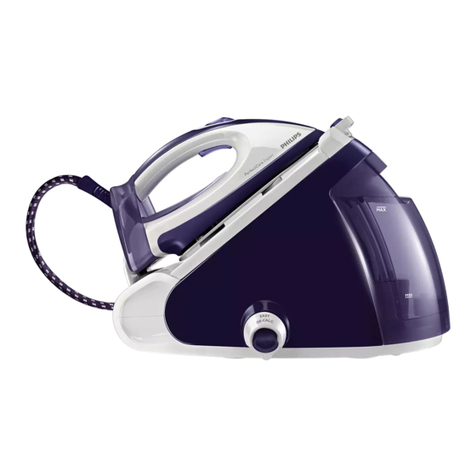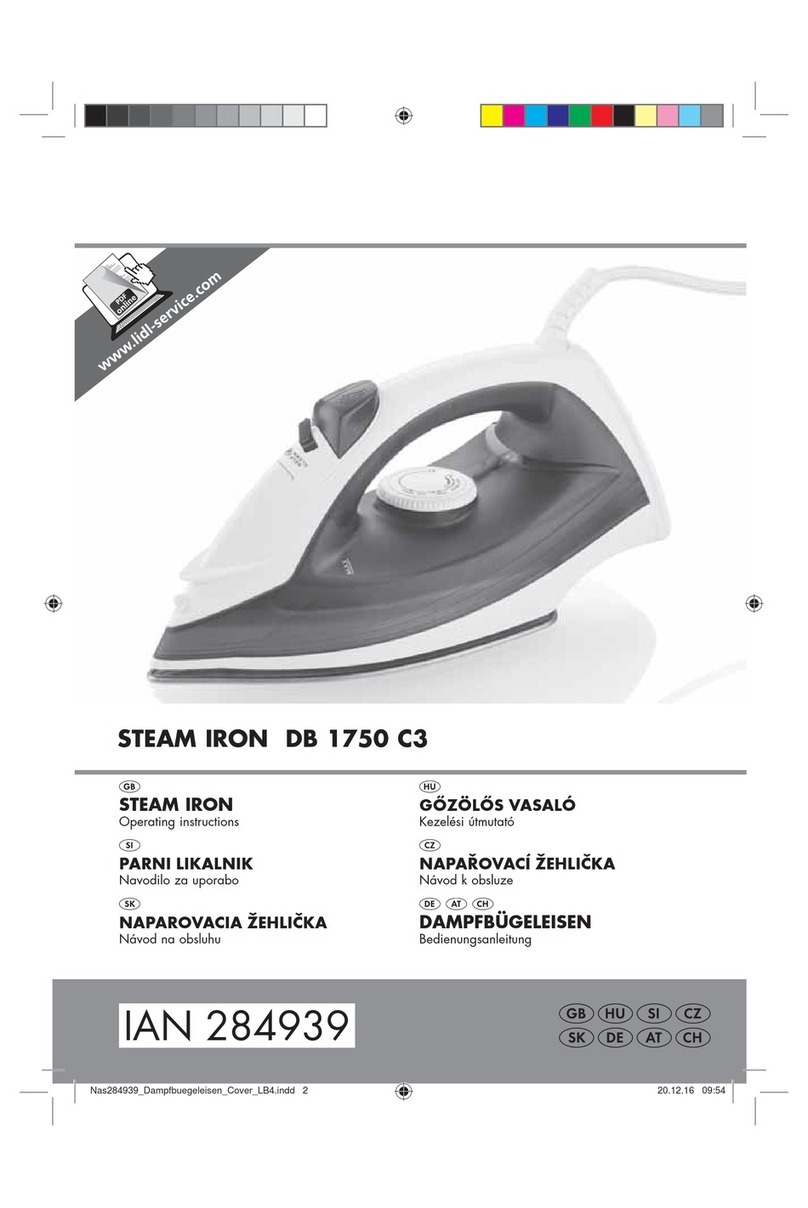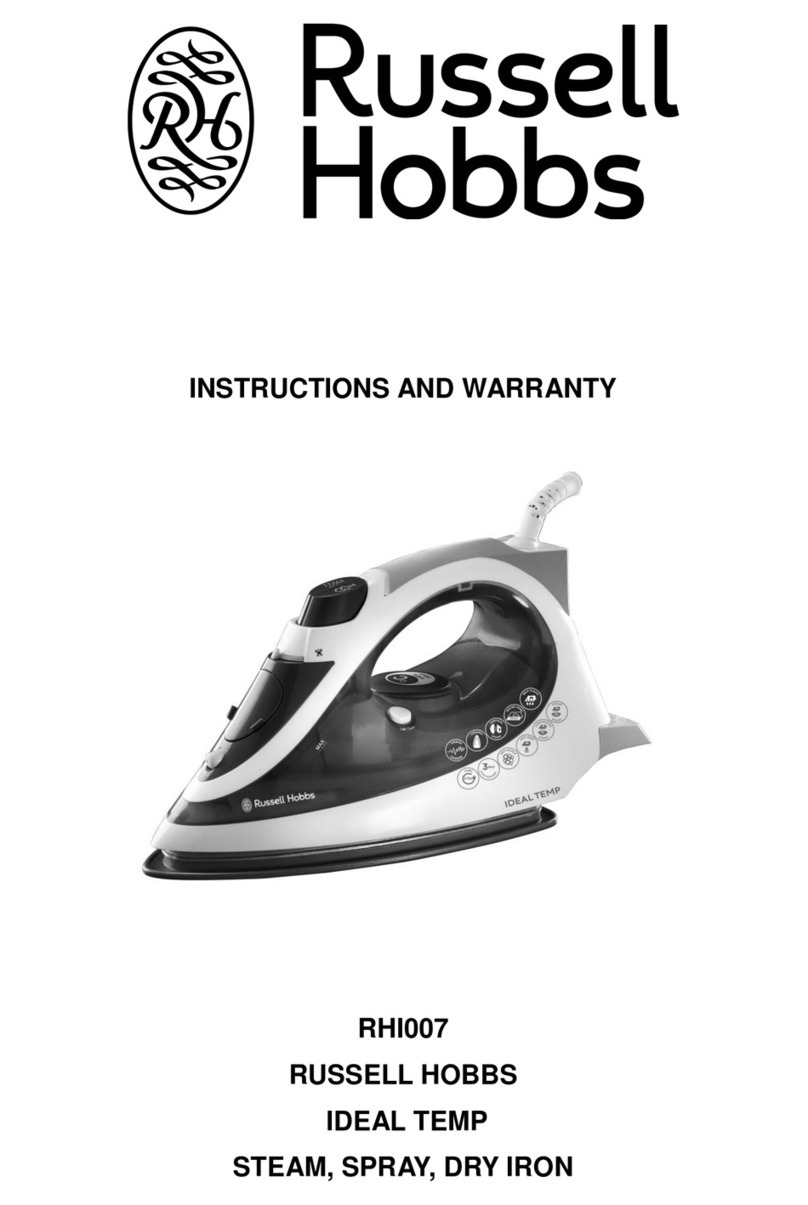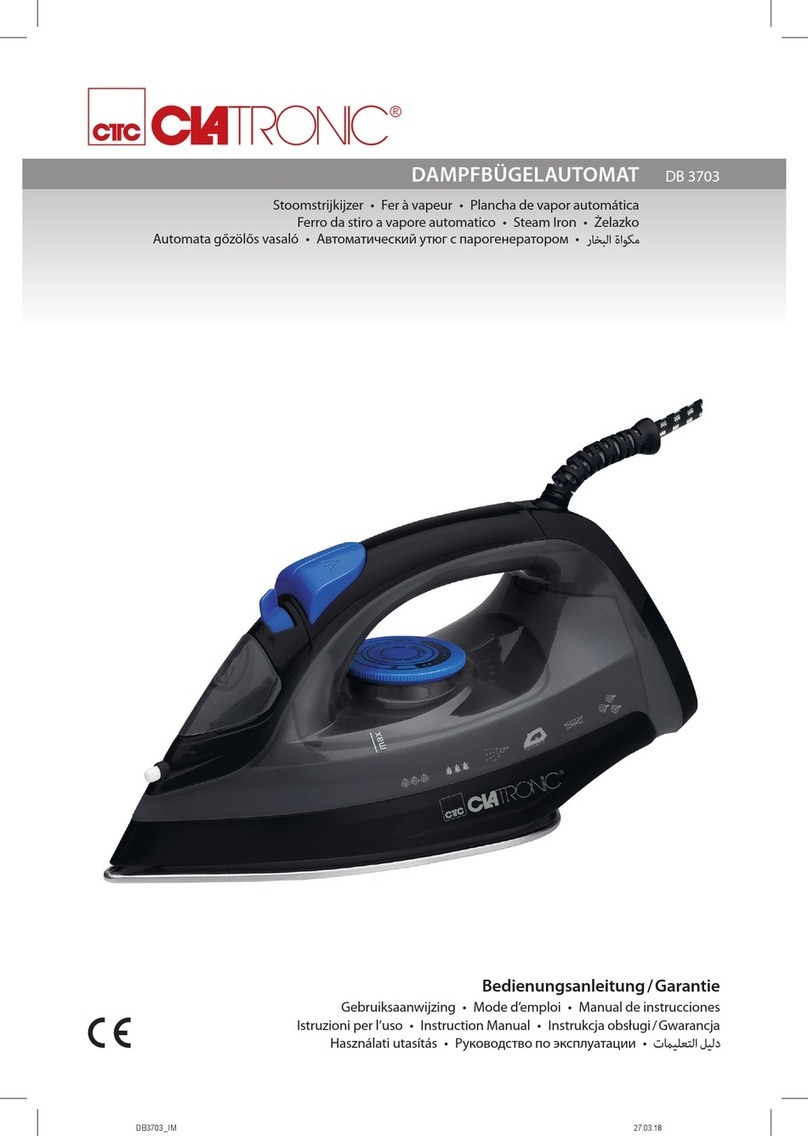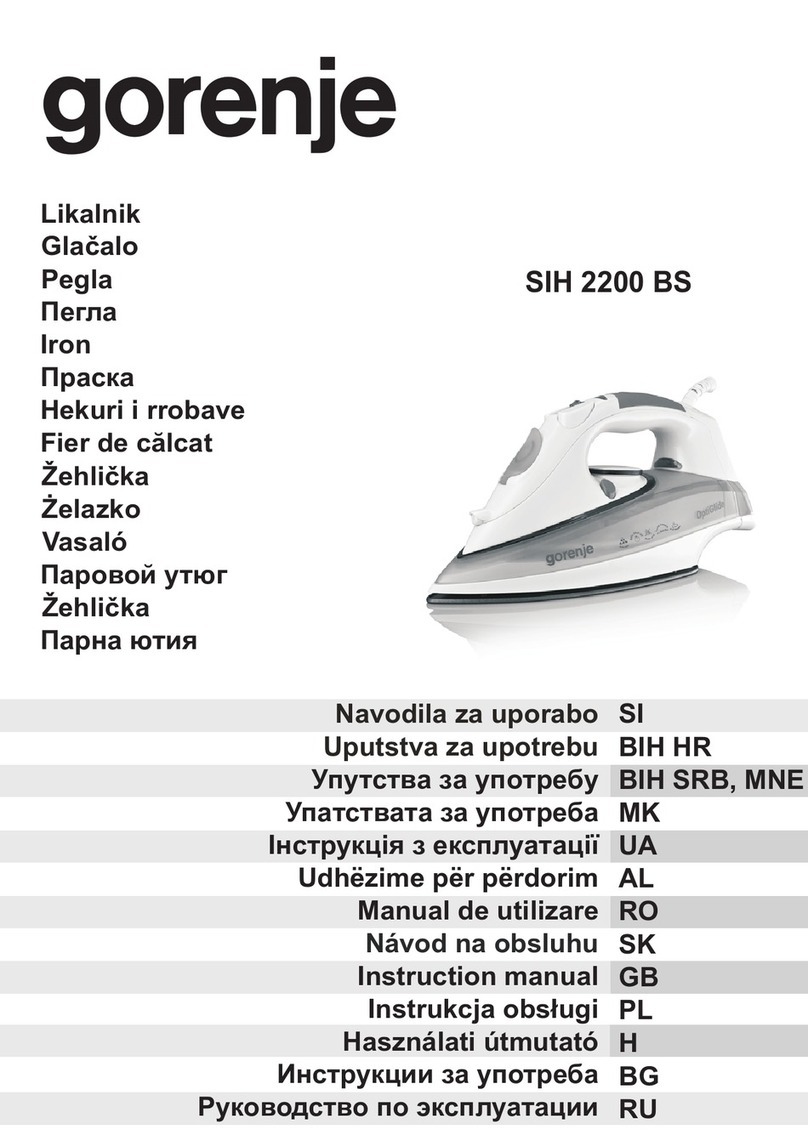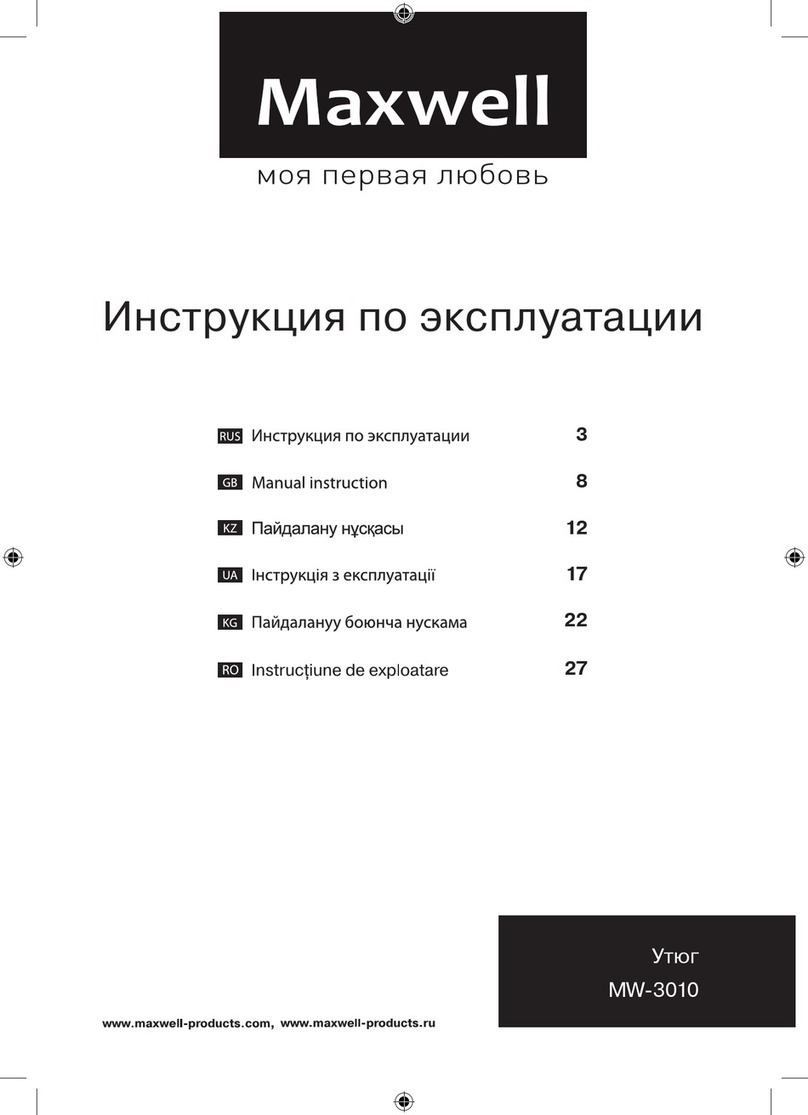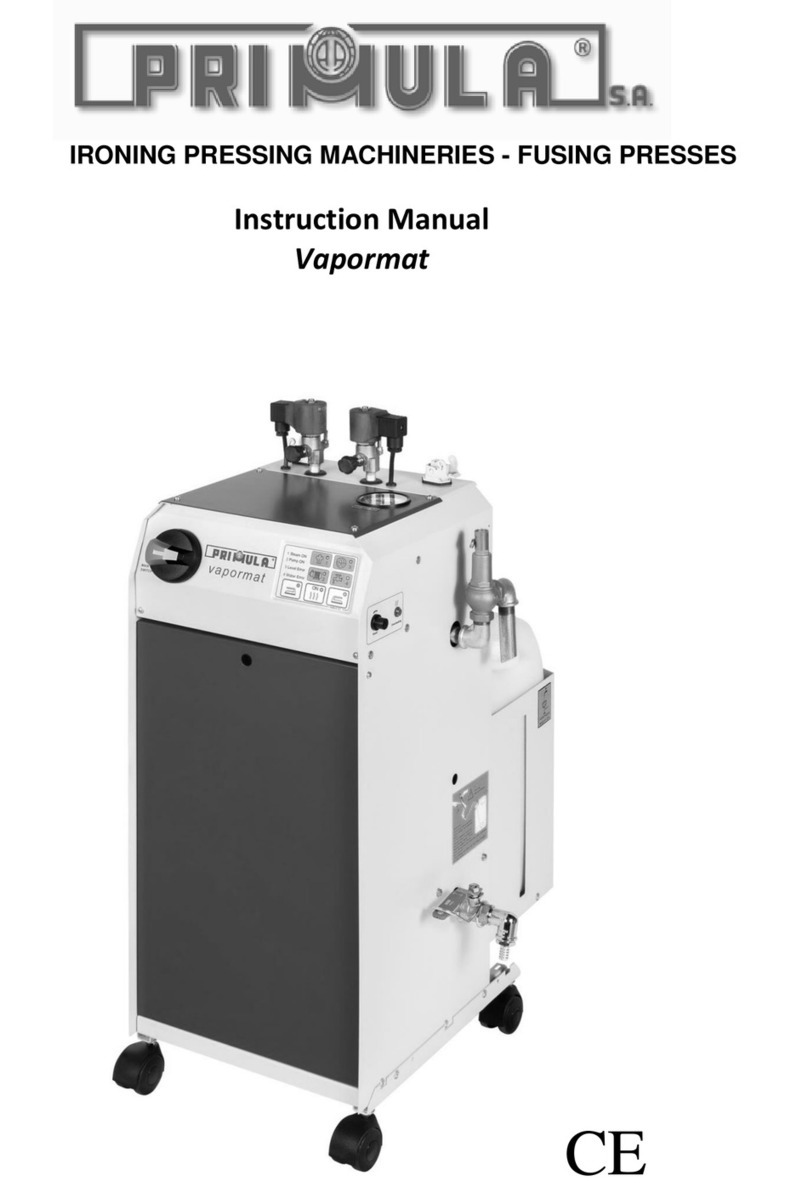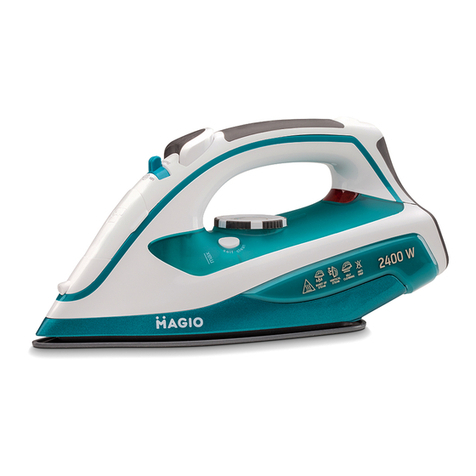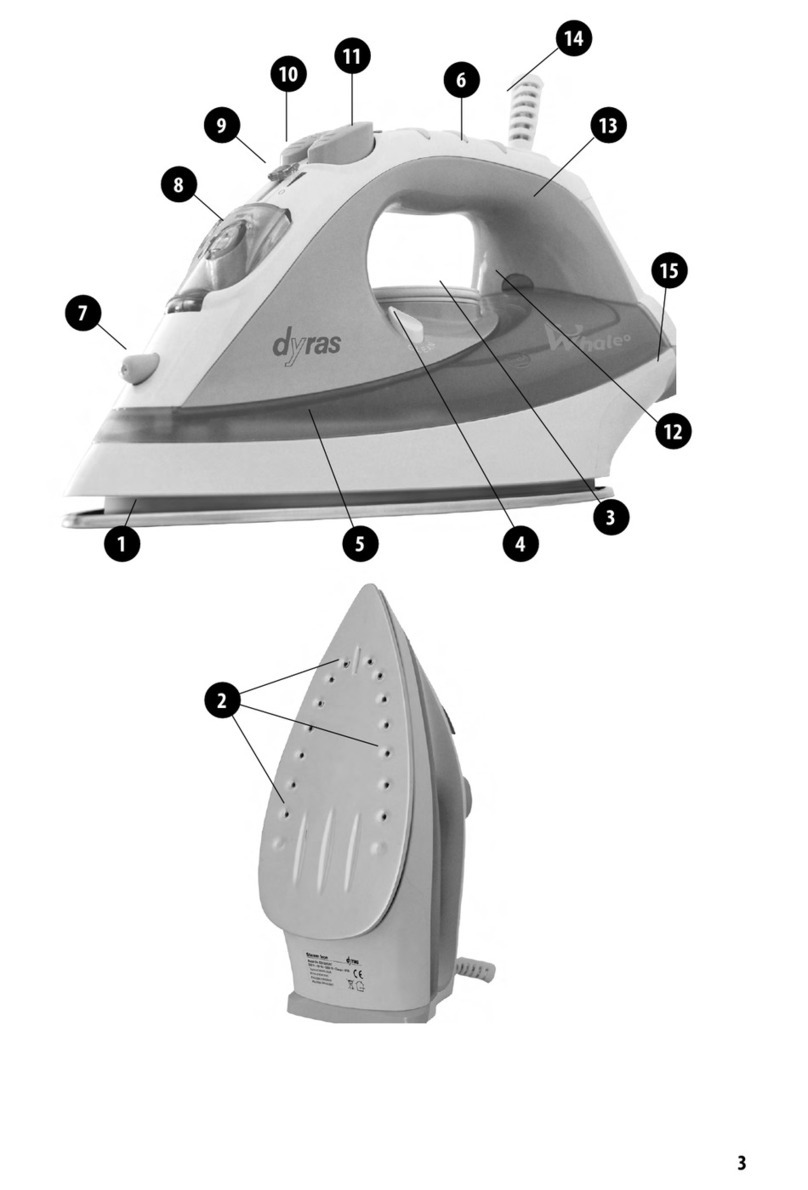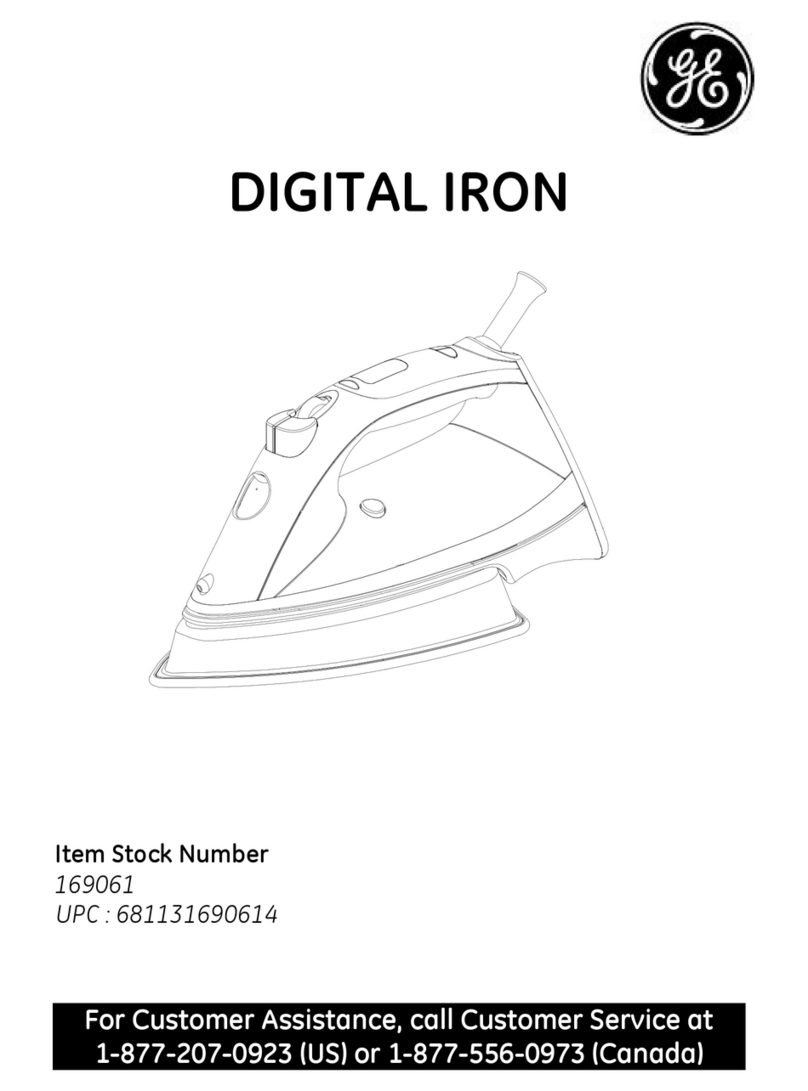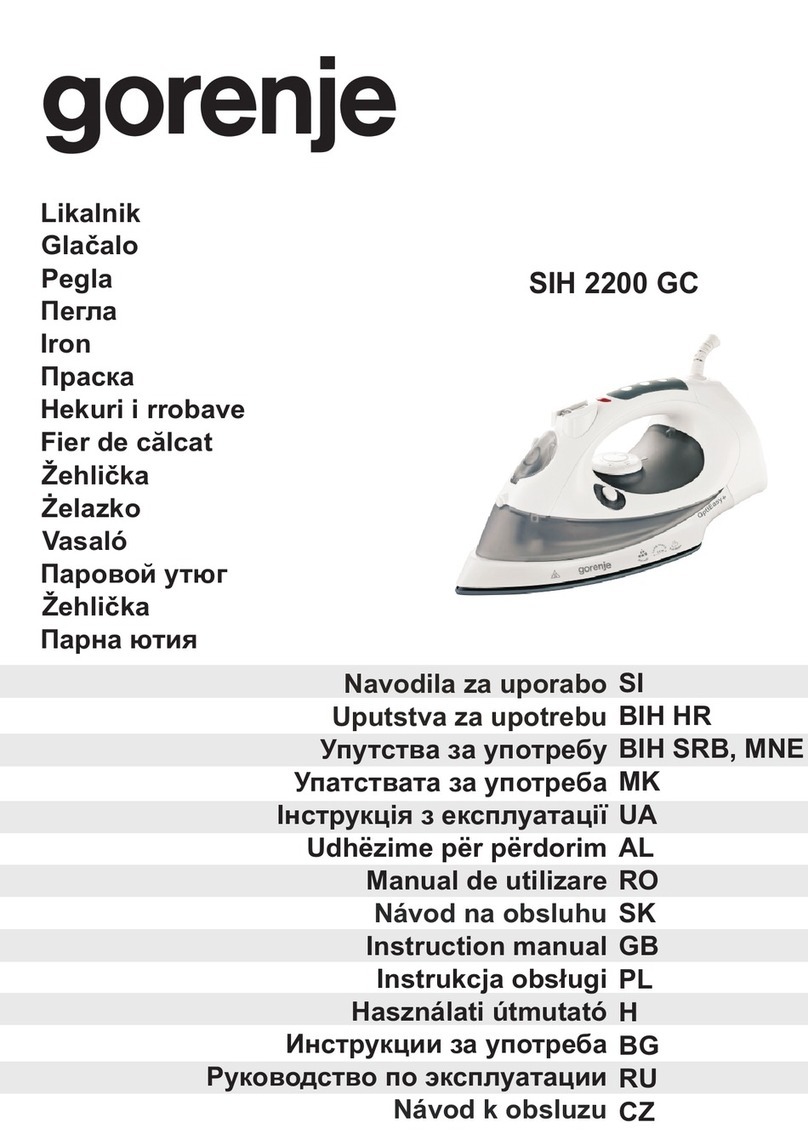Español ΕΛΛΗΝΙΚΑ
Γενική περιγραφή (Eικ. 1)
AKουµπί θερµοκρασίας (στρέψε)
BΠλάκα σίδερου
Cνδεικτικ" λαµπάκι θερµοκρασίας
DΠλήκτρο ψεκασµού T(πιέστε)
EΣτ"µιον ψεκασµού
FΠλήκτρο απελευθέρωσης εξαρτήµατος ψεκασµού (πιέστε)
G∆οχείο νερού ψεκασµού
HΠινακίδα µε τον τύπο της συσκευής
IΠίσω πλευρά
JKαλώδιο ρεύµατος
KΣυνδετήρας καλωδίου ρεύµατος
Θερµοκρασία σιδερώµατος
• Eλέγχετε πάντοτε αν υπάρχει ετικέτα µε οδηγίεσ στο ρούχο που
θέλετε να σιδερ σετε.
Aκολουθείτε τισ οδηγίεσ σιδερ µατοσ σε λεσ τισ περιπτ σεισ.
• Aν στο ρούχο δεν υπάρχουν οδηγίεσ για το σιδέρωµα αλλά
γνωρίζετε το είδoσ του θφάσµατοσ επιλέξτε:
1(χαµηλή θερµoκρασία) για συνθετικά (π.χ. ακρυλικά, βισκζ,
πολυεστέρασ κλπ) και για µεταξωτά υφάσµατα.
2(µέτρια θερµοκρασία) για τα µάλλινα
3(υψηλή θερµοκρασιά) για τα βαµβακερά και λινά.
• Αυτέσ οι οδηγίεσ ισχύουν µνο για υφάσµατα. Αν πάνω στο ύφασµα
υπάρχει κάποιο τελείωµα (πιέτεσ, κρσια κ.λ.π.) ττε το σιδέρωµα
θα πρέπει να γίνει σε χαµηλτερη θερµοκρασιά.
• ∆ιαχωρίστε τα υφάσµατα ανάλογα µε τισ θερµοκρασίεσ
σιδερ µατοσ: τα µάλλινα µε τα µάλλινα, τα βαµβακερά µε τα
βαµβακερά κ.λπ.
Tο σίδερο ζεσταίνεται γρηγορτερα απ' τι κρυ νει, έτσι αρχίστε το
σιδέρωµα πρ τα µε τα ρούχα που χρειάζονται τη χαµηλτερη
θερµοκρασία πωσ π.χ. τα συνθετικά, συνεχίστε µε τα ρούχα που
χρειάζονται υψηλτερη θερµοκρασία και τελει στε µε τα
βαµβακερά και λινά.
• Aν το ύφασµα αποτελείται απ πολλ ν ειδ ν κλωστέσ, πρέπει να
χρησιµοποιείτε πάντοτε τη χαµηλτερη θερµοκρασία (π.χ. αν κάποιο
ύφασµα αποτελείται απ 60% πολυεστέρα και 40% βαµβάκι πρέπει
να σιδερ νεται µε το ρυθµιστή θερµοκρασίασ στη θέση πολυεστέρα
(1) και χωρίσ ατµ).
Aν δεν γνωρίζετε απ τι ύφασµα είναι κατασκευασµένο κάποιο
ρούχο κάντε δοκιµή σε κάποιο σηµείο του ρούχου που δεν φαίνεται
ταν το φοράτε. Aρχίστε απ χαµηλή θερµοκρασία και αυξάνετε
µέχρισ του βρείτε την κατάλληλη για το σιδέρωµα του ρούχου.
• Για να αποφύγετε τισ κηλίδεσ που σχηµατίζονται πάνω στο
βελούδινο ύφασµα, σιδερ στετο πάντα προσ την ίδια κατεύθυνση,
να πιέζετε το σίδερο ελαφρά και να το µετακινείτε γρήγορα.
• Σιδερ νετε τα συνθετικά και µεταξωτά υφάσµατα απ την ανάποδη
για να µη σχηµατίζονται κηλίδεσ. Mη τα ψεκάζετε για να
αποφεύγονται οι κηλίδεσ.
Γέµισµα του δοχείου µε νερ (για ψεκασµ)
Mπορείτε να γεµίσετε το δοχείο µε νερ τησ βρύσησ.
• Πατήστε το πλήκτρο απελευθέρωσησ (Eικ. 2) και βγάλτε το
εξάρτηµα ψεκασµού (Eικ. 3).
• Tραβείξτε έξω το πλήκτρο ψεκασµού (Eικ. 4).
• Γεµίστε το δοχείο νερού (Eικ. 5).
• Bάλτε πάλι στη θέση του το πλήκτρο ψεκασµού (KΛIK) (Eικ. 6).
• Bάλτε στη θέση του το εξάρτηµα ψεκασµού (KΛIK) (Eικ. 7).
Pύθµιση της θερµοκρασίας
- Pυθµίστε τηv κατάλληλη θερµοκρασία σιδερ µατοσ µε το κουµπί
θερµοκρασίασ (Eικ. 8). Γυρίστε το κουµπί θερµοκρασίασ ούτωσ στε
η ένδειξη τησ επιθυµητήσ θερµοκρασίασ στο κουµπί να έλθει
ακριβ σ απέναντι απ το ενδεικτικ φωτάκι στο σίδερο.
- Bάλτε το φισ στη πρίζα. Tο ενδεικτικ λαµπάκι ανάβει (Eικ. 9).
- ταν σβήσει το λαµπάκι και ανάψει πάλι αρχίστε το σιδέρωµα (Eικ.
10). Tο λαµπάκι σβήνει κατά διαστήµατα. Aυτ δεν έχει καµιά
σηµασία, συνεχίστε το σιδέρωµα.
- Aν ρυθµίσετε το κουµπί θερµοκρασίασ σε χαµηλτερη θερµοκρασία
αφού έχετε σιδερ σει πρ τα σε υψηλτερη, µην αρχίσετε να
σιδερ νετε προτού ανάψει πάλι το ενδεικτικ λαµπάκι.
Oδηγίες σιδερώµατος
• Σιδερ νετε µε ίσια τη πλάτη. Pυθµίστε το ύψοσ τησ σιδερ στρασ
ούτωσ στε η λαβή του σιδέρου να είναι στο ίδιο ύψοσ µε τον
αγκ να σασ.
• ∆εν χρειάζεται να πιέζετε το σίδερο αν έχετε ρυθµίσει την
θερµοκρασία σιδερ µατοσ σωστά. Tα ρούχα σιδερ νονται
καλύτερα αν είναι ελαφρ σ υγρά.
Ψεκασµ"ς
Πατ ντασ 2-3 φορέσ το πλήκτρο ψεκασµού σε οποιαδήποτε
θερµοκρασία τα ρούχα µουσκεύονται ελαφρ σ (Eικ. 11).
Bεβαιωθείτε τι υπάρχει αρκετ νερ στο δοχείο.
3ταν τελειώσετε το σιδέρωµα
- Bάλτε το σίδερο ρθιο (Eικ. 12).
- Στρέψτε το κουµπί θερµοκρασίασ στη θέση “MIN” (Eικ. 13).
- Bγάλτε το καλ διο ρεύµατοσ απ την πρίζα του τοίχου (Eικ. 14).
- Aφήστε το σίδερο να κρυ σει για 30 λεπτά τουλάχιστον.
- Tυλίξτε το καλ διο ρεύµατοσ (Eικ. 15) και στερε στε το µε τον
σινδετήρα (Eικ. 16).
- Aποθηκεύστε το σίδερο σε ρθια θέση για να µην υποστεί βλάβη η
πλάκα (Eικ. 17).
Kαθαρισµ"ς
- Πριν τον καθαρισµ βγάλτε το καλ διο ρεύµατοσ απ την πριζα και
περιµένετε µέχρι να κρυ σει το σίδερο καλά.
- Mπορείτε να καθαρίσετε το σίδερο µε ένα υγρ πανί.
Descrição geral (fig. 1)
ARegulador de temperatura (rodar)
BBase
CLâmpada piloto da temperatura
DBotão para borrifar T(premir)
EBocal do borrifador
FBotão para soltar o borrifador (premir)
GDepósito de água do borrifador
HPlaca de identificação
IParte traseira
JCabo de alimentação
KGancho
Temperatura
• Verifique sempre primeiro se existe uma etiqueta com instruções na peça
de roupa que vai engomar.
Siga sempre essas instruções.
• Se não tiver as instruções do seu ferro à mão mas se conhecer o tipo de
tecido, seleccione:
1(temperatura baixa) para matérias sintéticas (p. ex. acetato, acrílico,
viscose, poliamide, poliester) e para sedas;
2(temperatura moderada) para lãs;
3(quente) para algodões e linhos.
• Estas instruções aplicam-se apenas a fibras se os tecidos tiverem
qualquer tipo de acabamento (brilho, pregas, relevo, etc.) ficarão
melhores se forem passados a uma temperatura baixa.
• Escolha primeiro os tecidos de acordo com a temperatura: lã para lã,
algodão para algodão, etc.
• O ferro aquece rapidamente, mas arrefece mais devagar. Por
conseguinte, comece a passar as peças que precisem de temperaturas
mais baixas, como é o caso dos tecidos sintéticos. Progrida depois para
as temperaturas mais elevadas. Termine com as peças de algodão e de
linho.
• Se a peça for feita de uma mistura de fibras diferentes, deverá
seleccionar sempre as temperaturas mais baixas para fibras.
(Por exemplo, uma peça que consista em 60% de poliester e 40% de
algodão deverá ser passada a uma temperatura indicada para
poliester (1).
• Se desconhecer o(s) tipo(s) de tecido(s) de que a peça é feita,
experimente primeiro num sítio que não fique à vista para saber a
temperatura adequada. (Comece sempre numa temperatura mais baixa e
vá aumentando até obter os resultados desejados).
• Veludo e outros tecidos que ganham brilho muito rapidamente, deverão
ser passadas apenas numa direcção (a favor do pêlo), fazendo uma
ligeira pressão. O ferro deverá estar sempre em movimento.
• Passe o avesso dos tecidos sintéticos e da seda para evitar que ganhem
brilho. Para não manchar o tecido não utilize o borrifador em seda e
noutros tecidos delicados.
Enchimento do depósito (para borrifar)
• O depósito do borrifador pode ser cheio com água normal da
torneira.
- Prima o botão de soltar (fig. 2) e retire o borrifador (fig. 3).
- Puxe o botão do borrifador (fig. 4).
- Encha o depósito de água (fig. 5).
- Volte a colocar o botão ("Clique!") (fig. 6).
- Volte a colocar o borrifador ("Clique!") (fig. 7).
Programação da temperatura
- Seleccione a temperatura adequada fazendo rodar o selector (fig. 8).
Rode o selector de temperatura até que a indicação da temperatura
desejada fique junto à lâmpada piloto do ferro.
- Introduza a ficha na tomada de corrente. A lâmpada piloto acender-se-á
(fig. 9).
- Depois da lâmpada piloto se apagar e voltar a acender, poderá começar a
passar (fig. 10).
• A lâmpada piloto acende-se de tempos a tempos enquanto estiver a
passar. Isso não produz qualquer efeito no trabalho, por isso prossiga
sem preocupações.
• Se posicionar o selector numa temperatura mais baixa depois de ter
utilizado uma temperatura mais elevada, não recomece a passar antes da
lâmpada piloto voltar a acender.
Algumas sugestões
• Passe com as costas direitas. Ajuste a altura da tábua de engomar de
modo que a pega do ferro fique ao mesmo nível do seu cotovelo.
• Não é preciso fazer força sobre o ferro se a temperatura tiver sido
correctamente seleccionada. Passar a ferro torna-se mais fácil e é mais
eficaz se a roupa estiver ligeiramente humedecida.
Borrifar
Seja qual for a temperatura, poderá carregar no botão do borrifador para
humedecer a roupa ligeiramente (fig. 11).
Verifique sempre se o depósito tem água suficiente.
Quando terminar de passar
- Coloque o ferro assente na parte de trás (fig. 12).
- Posicione o selector de temperatura em "MIN" (fig. 13).
- Retire a ficha da tomada de corrente (fig. 14).
- Deixe o ferro arrefecer durante um mínimo de 30 minutos.
- Depois, poderá enrolar o fio (fig. 15) e fixar a extremidade no gancho
(fig. 16).
- Guarde o ferro assente na parte de trás para evitar danificar a base
(fig. 17).
Limpeza
- Antes de limpar, retire a ficha da tomada de parede e deixe o ferro
arrefecer o suficiente.
- O aparelho pode ser limpo com um pano húmido.
ΩÉ©dG ∞°UƒdGΩÉ©dG ∞°UƒdG(1 º°SôdG)(1 º°SôdG)
AAIQGô◊G áLQO º¶æeIQGô◊G áLQO º¶æe(QOCG)(QOCG)
BBπ©ædG ìƒdπ©ædG ìƒd CC»Fƒ°†dG π«dódG /IQGô◊G áLQO ô°TDƒe»Fƒ°†dG π«dódG /IQGô◊G áLQO ô°TDƒe DD TôdG QR TôdG QRTT(§¨°VEG)(§¨°VEG)
EEá°Tôeá°Tôe FF TôdG QR ü«∏îJ QR TôdG QR ü«∏îJ QR(§¨°VEG)(§¨°VEG)
GG
qTô∏d AÉŸG ¿GõNq Tô∏d AÉŸG ¿GõN HH´ƒædG áMƒd´ƒædG áMƒd IIRÉ¡÷G IôNDƒeRÉ¡÷G IôNDƒe JJ∂∏°ùdG∂∏°ùdG KK∂∏°ùdG ∂Ñ°ûe∂∏°ùdG ∂Ñ°ûe
…ƒµdG IQGôM áLQO…ƒµdG IQGôM áLQO``ɪFGO ô¶fCGɪFGO ô¶fCGiƒµdG äɪ«∏©àdiƒµdG äɪ«∏©àdäGOÉ°TQE’G ä’É◊G ™«ªL ‘ ™ÑJEG .É¡jƒc OGôŸG áé°ùfC’G≈∏Y áWƒ«ıGäGOÉ°TQE’G ä’É◊G ™«ªL ‘ ™ÑJEG .É¡jƒc OGôŸG áé°ùfC’G≈∏Y áWƒ«ıG.…ƒµdG äɪ«∏©J ‘ IÉ£©ŸG.…ƒµdG äɪ«∏©J ‘ IÉ£©ŸG ``:ÎNCÉa ,¢Tɪ≤dG ´ƒf ±ô©Jh …ƒµ∏d äɪ«∏©J óŒ ⁄GPEG:ÎNCÉa ,¢Tɪ≤dG ´ƒf ±ô©Jh …ƒµ∏d äɪ«∏©J óŒ ⁄GPEG
11∂dòch (ΰù«dƒÑdG h ó«eÉ«dƒÑdG ,Rƒµ°ù«ØdG ,πjôcC’G ,äÉà«°SC’G πãe) áq«YÉ棰UE’G ±É«dCÓd (É«fO áLQO)∂dòch (ΰù«dƒÑdG h ó«eÉ«dƒÑdG ,Rƒµ°ù«ØdG ,πjôcC’G ,äÉà«°SC’G πãe) áq«YÉ棰UE’G ±É«dCÓd (É«fO áLQO)
.ôjô◊G.ôjô◊G
22(ádóà©e IQGôM áLQO)(ádóà©e IQGôM áLQO);±ƒ°ü∏d;±ƒ°ü∏d 33(á«dÉY IQGôM áLQO)(á«dÉY IQGôM áLQO)ø£≤∏dø£≤∏dhh¿ÉàµdG¿ÉàµdG.. ``hCG ¢ù∏eCG hCG Gó©› ¢Tɪ≤dG ¿Éc GPEÉa ;Ée á≤jôW …CÉH á÷É©ŸG ÒZ ¢Tɪ≤dG ´GƒfCG ¢üîJ äɪ«∏©àdG √òghCG ¢ù∏eCG hCG Gó©› ¢Tɪ≤dG ¿Éc GPEÉa ;Ée á≤jôW …CÉH á÷É©ŸG ÒZ ¢Tɪ≤dG ´GƒfCG ¢üîJ äɪ«∏©àdG √òg
.á¶Øîæe IQGôM áLQóH ¬jƒµJ ¿CG ø°ùëà°ù«a (äGó©Œ hCG äÉjƒW hCG ¿É©Ÿ) ™ª∏e.á¶Øîæe IQGôM áLQóH ¬jƒµJ ¿CG ø°ùëà°ù«a (äGó©Œ hCG äÉjƒW hCG ¿É©Ÿ) ™ª∏e``...ø£≤dG ™e ø£≤dG h ±ƒ°üdG ™e ±ƒ°üdG Éeó≤e É¡jƒc ‘ ÖZôJ »àdG á°ûªbC’G RôaEG...ø£≤dG ™e ø£≤dG h ±ƒ°üdG ™e ±ƒ°üdG Éeó≤e É¡jƒc ‘ ÖZôJ »àdG á°ûªbC’G RôaEG ``É¡jƒc Öéj »àdG á«YÉ棰UE’G á°ûªbC’ÉH CGóÑJ ¿CG π°†aC’Éa ∂dòdh ;A§ÑH OÈJ É¡æµdh áYô°ùH øî°ùJ IGƒµŸGÉ¡jƒc Öéj »àdG á«YÉ棰UE’G á°ûªbC’ÉH CGóÑJ ¿CG π°†aC’Éa ∂dòdh ;A§ÑH OÈJ É¡æµdh áYô°ùH øî°ùJ IGƒµŸG
h ø£≤dG …ƒµd ≈∏YCG IQGôM äÉLQód ÉÄ«°ûa ÉÄ«°T êQóJ ºK á«YÉ棰UE’G ±É«dC’G πãe á°†Øîæe IQGôM áLQOh ø£≤dG …ƒµd ≈∏YCG IQGôM äÉLQód ÉÄ«°ûa ÉÄ«°T êQóJ ºK á«YÉ棰UE’G ±É«dC’G πãe á°†Øîæe IQGôM áLQO
.¿ÉàµdG.¿ÉàµdG ``á«°SÉ°ùM ÉgÌcCG ™e ºFÓàJ »àdG IQGô◊G áLQO »≤àfEÉa ,á«YƒædG áØ∏àfl±É«dCG øe Éfƒµe ¢Tɪ≤dG ¿Éc GPEGá«°SÉ°ùM ÉgÌcCG ™e ºFÓàJ »àdG IQGô◊G áLQO »≤àfEÉa ,á«YƒædG áØ∏àfl±É«dCG øe Éfƒµe ¢Tɪ≤dG ¿Éc GPEG
) ΰù«dƒÑ∏d IQGô◊G áLQO »≤àfEÉa ,ø£b %40h ΰù«dƒH %60 øe ¢Tɪ≤dG á©£b âfƒµJ GPEG :Óãe)) ΰù«dƒÑ∏d IQGô◊G áLQO »≤àfEÉa ,ø£b %40h ΰù«dƒH %60 øe ¢Tɪ≤dG á©£b âfƒµJ GPEG :Óãe)
11’h (’h ( (.É°†jCG GQÉîÑdG Ωóîà°ùJ(.É°†jCG GQÉîÑdG Ωóîà°ùJ ``h ;¬eóîà°ùJ hCG ¬jóJôJ ÉeóæY ô¡¶j ød ¬æe AõL øY åëHEÉa ¢Tɪ≤dG á©£≤d ¿ƒµŸG è«°ùædG ±ô©J ’ âæc GPEGh ;¬eóîà°ùJ hCG ¬jóJôJ ÉeóæY ô¡¶j ød ¬æe AõL øY åëHEÉa ¢Tɪ≤dG á©£≤d ¿ƒµŸG è«°ùædG ±ô©J ’ âæc GPEG
(.á°†Øîæe IQGôM áLQóH ’hCG CGóHEG) .¬d ¬Ñ°SÉæŸG IQGô◊G áLQO ±É°ûàcE’ ¬«a ÜôL(.á°†Øîæe IQGôM áLQóH ’hCG CGóHEG) .¬d ¬Ñ°SÉæŸG IQGô◊G áLQO ±É°ûàcE’ ¬«a ÜôL ``™°Vh ≈∏YCG ≈∏Y QÉîÑdG QR ™°†J ¿CG π°†aC’Gh ;QÉîÑdÉH (±ƒ°U %100) ¢üdÉÿG ±ƒ°üdG ¢Tɪb …ƒc øµÁ™°Vh ≈∏YCG ≈∏Y QÉîÑdG QR ™°†J ¿CG π°†aC’Gh ;QÉîÑdÉH (±ƒ°U %100) ¢üdÉÿG ±ƒ°üdG ¢Tɪb …ƒc øµÁ
.É¡dÓN øe …ƒµ∏d áaÉL ¢Tɪb á©£b Ωóîà°ùJ ¿CG h.É¡dÓN øe …ƒµ∏d áaÉL ¢Tɪb á©£b Ωóîà°ùJ ¿CG h ``Ö∏≤H ∂dP çhóM ™æ“ ¿CG ∂æµÁh ,QÉîÑdÉH á«aƒ°üdG á°ûªbC’G …ƒc óæY á©e’ øcÉeCG ô¡¶J ¿CG øµÁÖ∏≤H ∂dP çhóM ™æ“ ¿CG ∂æµÁh ,QÉîÑdÉH á«aƒ°üdG á°ûªbC’G …ƒc óæY á©e’ øcÉeCG ô¡¶J ¿CG øµÁ
.É¡æe á«∏NGódG á¡÷G …ƒch ¢ùHÓŸG.É¡æe á«∏NGódG á¡÷G …ƒch ¢ùHÓŸG ``‘) §≤a óMGh √ÉŒEG ‘ ,É¡«∏Y á©e’ øcÉeCG ô¡¶J ¿CG øµÁ »àdG iôNC’G á«∏ªıG áé°ùfC’Gh áØ«£≤dG …ƒcEG‘) §≤a óMGh √ÉŒEG ‘ ,É¡«∏Y á©e’ øcÉeCG ô¡¶J ¿CG øµÁ »àdG iôNC’G á«∏ªıG áé°ùfC’Gh áØ«£≤dG …ƒcEG
.ácôM ‘ ɪFGO IGƒµŸG ¿ƒµJ ¿CG ¢UôMEG ;¬«∏Y §¨°†J ¿CG ¿hóH h (ôHƒdG √ÉŒEG.ácôM ‘ ɪFGO IGƒµŸG ¿ƒµJ ¿CG ¢UôMEG ;¬«∏Y §¨°†J ¿CG ¿hóH h (ôHƒdG √ÉŒEG ``Ωóîà°ùJ ’h .á©eÓdG øcÉeC’G Qƒ¡X ™æªàd πNGódG øe ôjô◊G h á«YÉ棰UE’G á°ûªbC’G …ƒµJ ¿CG π°†aC’GΩóîà°ùJ ’h .á©eÓdG øcÉeC’G Qƒ¡X ™æªàd πNGódG øe ôjô◊G h á«YÉ棰UE’G á°ûªbC’G …ƒµJ ¿CG π°†aC’G
.™≤ÑdG É¡«a ô¡¶J ób ’EG h á°TôŸG òFóæY.™≤ÑdG É¡«a ô¡¶J ób ’EG h á°TôŸG òFóæY
AÉŸÉH AπŸGAÉŸÉH AπŸG(¢Tô∏d)(¢Tô∏d) ``.…OÉ©dG QƒÑæ°üdG AÉà IGƒµŸG CÓe øµÁ.…OÉ©dG QƒÑæ°üdG AÉà IGƒµŸG CÓe øµÁ ``.(3 º°SôdG) q¢TôdG IóMh ™∏NEG h (2 º°SôdG) íjô°ùàdG QR ≈∏Y §¨°VEG.(3 º°SôdG) q¢TôdG IóMh ™∏NEG h (2 º°SôdG) íjô°ùàdG QR ≈∏Y §¨°VEG ``.(4 º°SôdG) ¢TôdG QR ÜòLEG.(4 º°SôdG) ¢TôdG QR ÜòLEG ``.(5 º°SôdG) AÉŸG ¿GõN CÓeEG.(5 º°SôdG) AÉŸG ¿GõN CÓeEG ``.(6 º°SôdG) (áµJ ™ª°ùJ) ¢TôdG QR ™LQCG.(6 º°SôdG) (áµJ ™ª°ùJ) ¢TôdG QR ™LQCG ``.(7 º°SôdG) (áµJ ™ª°ùJ) ¢TôdG IóMh ™LQCG.(7 º°SôdG) (áµJ ™ª°ùJ) ¢TôdG IóMh ™LQCG
IQGô◊G áLQO §Ñ°VIQGô◊G áLQO §Ñ°V``áLQódG IQÉ°TEG ∞bƒàJ ≈àM ìÉàØŸG QOCG .(8 º°SôdG) IQGô◊G áLQO º¶æe ᣰSGƒH IQGô◊G áLQO §Ñ°VEGáLQódG IQÉ°TEG ∞bƒàJ ≈àM ìÉàØŸG QOCG .(8 º°SôdG) IQGô◊G áLQO º¶æe ᣰSGƒH IQGô◊G áLQO §Ñ°VEG
.»Fƒ°†dG π«dódG ΩÉeCG É¡«a ܃ZôŸG.»Fƒ°†dG π«dódG ΩÉeCG É¡«a ܃ZôŸG ``.(9 º°SôdG) »Fƒ°†dG π«dódG π©à°ûj .¢ùÑ≤ŸG ‘ ¢ùHÉ≤dG πNOCG.(9 º°SôdG) »Fƒ°†dG π«dódG π©à°ûj .¢ùÑ≤ŸG ‘ ¢ùHÉ≤dG πNOCG ``.(10 º°SôdG) …ƒµdG ‘ AóÑdG ∂æµÁ á«fÉK AÉ°VCG ºK ’hCG »Fƒ°†dG π«dódG CÉØ£fEG GPEG.(10 º°SôdG) …ƒµdG ‘ AóÑdG ∂æµÁ á«fÉK AÉ°VCG ºK ’hCG »Fƒ°†dG π«dódG CÉØ£fEG GPEG ••≈∏Y ÒKCÉJ …CG É¡d ¢ù«dh ájOÉY IôgÉX √òg ,¿É«MC’G ¢†©H ÅØ£æj h »Fƒ°†dG π«dódG π©à°ûj …ƒµdG AÉæKCG≈∏Y ÒKCÉJ …CG É¡d ¢ù«dh ájOÉY IôgÉX √òg ,¿É«MC’G ¢†©H ÅØ£æj h »Fƒ°†dG π«dódG π©à°ûj …ƒµdG AÉæKCG
.RÉ¡÷G.RÉ¡÷G ••…ƒµdG ‘ CGóÑJ Óa á°†Øîæe IQGôM áLQO ≈∏Y IQGô◊G áLQO º¶æe â©°Vh ºK á«dÉY IQGôM áLQóH âjƒc GPEG…ƒµdG ‘ CGóÑJ Óa á°†Øîæe IQGôM áLQO ≈∏Y IQGô◊G áLQO º¶æe â©°Vh ºK á«dÉY IQGôM áLQóH âjƒc GPEG
.á«fÉK »Fƒ°†dG π«dódG Å«°†j ¿CG ó©H ’EG ójóL øe.á«fÉK »Fƒ°†dG π«dódG Å«°†j ¿CG ó©H ’EG ójóL øe
…ƒµ∏d äɪ«∏©J…ƒµ∏d äɪ«∏©J
••
qƒ∏Y ¿ƒµj å«ëH …ƒµdG ádhÉW á«WƒJ hCG á«∏©àH ºb .ɪ«≤à°ùe ∑ô¡X ¿ƒµj ¿CG ¢UôMCG h á°ûªbC’G …ƒcEGqƒ∏Y ¿ƒµj å«ëH …ƒµdG ádhÉW á«WƒJ hCG á«∏©àH ºb .ɪ«≤à°ùe ∑ô¡X ¿ƒµj ¿CG ¢UôMCG h á°ûªbC’G …ƒcEG
.≥aôŸG iƒà°ùe ™e ÉjhÉ°ùàe IGƒµŸG.≥aôŸG iƒà°ùe ™e ÉjhÉ°ùàe IGƒµŸG ••Ó¡°S …ƒµdG ¿ƒµj .áÑ°SÉæŸG »g QÉàıG IQGô◊G áLQO âfÉc GPEG Ió°ûH IGƒµŸG ≈∏Y §¨°†dG ΩRÓdG øe ¢ù«dÓ¡°S …ƒµdG ¿ƒµj .áÑ°SÉæŸG »g QÉàıG IQGô◊G áLQO âfÉc GPEG Ió°ûH IGƒµŸG ≈∏Y §¨°†dG ΩRÓdG øe ¢ù«d
.áÑWQ á°ûªbC’G âfÉc GPEG.áÑWQ á°ûªbC’G âfÉc GPEG
TôdGTôdG
.(11 º°SôdG) É¡H …ƒµJ ¿ƒµJ IQGôM áLQO …CG ‘ ¢Tɪ≤dG á©£b π«∏ÑJ ∂æµÁ äGôe IóY QõdG ≈∏Y §¨°†dÉH.(11 º°SôdG) É¡H …ƒµJ ¿ƒµJ IQGôM áLQO …CG ‘ ¢Tɪ≤dG á©£b π«∏ÑJ ∂æµÁ äGôe IóY QõdG ≈∏Y §¨°†dÉH
.¿GõÿG ‘ ±Éc AÉe OƒLh øe ócCÉJ.¿GõÿG ‘ ±Éc AÉe OƒLh øe ócCÉJ
…ƒµdG ΩÉ“EG óæY…ƒµdG ΩÉ“EG óæY
.(12 º°SôdG) É¡JôNDƒe ≈∏Y IGƒµŸG ™°V.(12 º°SôdG) É¡JôNDƒe ≈∏Y IGƒµŸG ™°V
™°VƒdG ≈∏Y IQGô◊G áLQO º¶æe ™°V™°VƒdG ≈∏Y IQGô◊G áLQO º¶æe ™°VMINNIM.(13 º°SôdG).(13 º°SôdG) .(14 º°SôdG) ¢ùÑ≤ŸG øe ¢ùHÉ≤dG ´õfEG.(14 º°SôdG) ¢ùÑ≤ŸG øe ¢ùHÉ≤dG ´õfEG
.πbC’G ≈∏Y á≤«bO 30 OÈàd IGƒµŸG ∑ôJCG.πbC’G ≈∏Y á≤«bO 30 OÈàd IGƒµŸG ∑ôJCG
.(16 º°SôdG) ∂Ñ°ûŸG ᣰSGƒH ¬ª«°SôJ h (15 º°SôdG) »FÉHô¡µdG ∂∏°ùdG ∞d ∂æµÁ.(16 º°SôdG) ∂Ñ°ûŸG ᣰSGƒH ¬ª«°SôJ h (15 º°SôdG) »FÉHô¡µdG ∂∏°ùdG ∞d ∂æµÁ
.(17 º°SôdG) π©ædG Ö«°üj ¿CG øµÁ Qô°V …CG Öæéàd É¡JôNDƒe ≈∏Y áØbGh IGƒµŸG ßØMEG.(17 º°SôdG) π©ædG Ö«°üj ¿CG øµÁ Qô°V …CG Öæéàd É¡JôNDƒe ≈∏Y áØbGh IGƒµŸG ßØMEG
∞«¶æàdG∞«¶æàdG
.ájÉصdG ¬«a Éà OÈàd IGƒµŸG ∑ôJCGh ∞«¶æàdG ‘ ´hô°ûdG πÑb ¢ùÑ≤ŸG øe ¢ùHÉ≤dG êôNCG.ájÉصdG ¬«a Éà OÈàd IGƒµŸG ∑ôJCGh ∞«¶æàdG ‘ ´hô°ûdG πÑb ¢ùÑ≤ŸG øe ¢ùHÉ≤dG êôNCG
.π∏Ñe πjóæe ΩGóîà°SEÉH π©ædG øe »°ù∏µdG AÉ°û¨dG ádGREG øµÁ.π∏Ñe πjóæe ΩGóîà°SEÉH π©ædG øe »°ù∏µdG AÉ°û¨dG ádGREG øµÁ
Importante
• Antes de usar el aparato, lean estas instrucciones observando
las ilustraciones al mismo tiempo.
• Antes de usar el aparato por vez primera, comprueben si el
voltaje indicado en su placa de características se corresponde
con el de su hogar.
• No usen nunca el aparato si tiene cualquier tipo de deterioro.
• Cuiden de que los niños no puedan tocar la plancha cuando esté
caliente y de que no puedan tirar del cable de red.
• No dejen que el conjunto cable de red + clavija toque la suela
cuando esté caliente.
• No sumerjan nunca la plancha en agua.
• Coloquen siempre la plancha sobre su parte trasera y sobre una
superficie firme y plana cuando interrumpan el planchado y
después de usarla Desenchufen siempre la plancha cuando la
dejen sola, aunque sea por corto tiempo.
• Mantengan pulida la suela y eviten los choques con objetos
metálicos.
• Algunas piezas de la plancha han sido ligeramente engrasadas
y, debido a ello, la plancha puede humear un poco al ponerla en
funcionamiento por vez primera aunque ello cesará al poco rato.
• No dejen la plancha sin vigilancia mientras esté enchufada a la
red eléctrica.
Descripción general (fig. 1)
AControl de la temperatura (giratorio)
BSuela
CLámpara piloto indicadora de la temperatura
DBotón del rociador T(presionar)
EBoquilla rociadora
FBotón de liberación de la unidad de rociado (presionar)
GDepósito de agua para el rociador
HPlaca de características
IParte trasera
JCable de red
KFijador del cable
Temperatura de planchado
• Comprueben siempre primero si la prenda a ser planchada está provista
de una etiqueta con instrucciones de planchado.
Sigan siempre esas instrucciones de planchado.
• Si no hay instrucciones de planchado pero conocen el tipo de tejido,
seleccionen :
1(Temperatura baja) para fibras sintèticas (por ejemplo : acetato,
acrílicos, viscosa, poliamida, poliester) y para seda.
2 (Temperatura moderada) para lana.
3 (Temperatura alta) para algodón y lino.
• Estas instrucciones son válidas solo para los materiales. Si se ha aplicado
algún tipo de acabado (satinado, arrugas, realces, etc.), es mejor
plancharlos a una temperatura más baja.
• Primero seleccionen la ropa a planchar de acuerdo con la temperatura de
planchado : lana con lana, algodón con algodón, etc.
• La plancha se calienta con más rapidez que se enfría. Por consiguiente,
empiecen planchando los artículos que necesiten la temperatura más
baja, como son los fabricados con fibras sintéticas y finalicen planchando
algodón y lino.
• Si el tejido está compuesto de varios tipos de fibras, deben seleccionar la
temperatura de planchado más baja de la composición. (Por ejemplo, una
prenda que tenga el 60 % de poliester y el 40 % de algodón, deben
plancharla con la temperatura del poliester (1)).
• Si no saben de qué fibra (s) está compuesto el artículo, busquen un lugar
que sea invisible cuando se lleve o use y prueben la temperatura de
planchado. (Empiecen siempre con una temperatura baja e increméntenla
hasta una que les de los resultados requeridos) .
• El terciopelo y otros tejidos que adquieran puntos brillantes con rapidez,
deben plancharlos solo en una dirección (la del pelo), aplicando una
presión ligera y sin dejar de mover la plancha.
• Planchen los materiales sintéticos y la seda por el revés, a fin de evitar
puntos brillantes. Para prevenir las manchas, no usen el rociador sobre
seda u otros tejidos delicados.
Llenado con agua (para rociar)
• Pueden llenar el depósito del agua con agua normal del grifo.
- Presionen el botón de liberación (fig. 2) y saquen la unidad de rociado
(fig. 3).
- Extraigan el botón del rociador (fig. 4).
- Llenen el depósito de agua (fig. 5).
- Vuelvan a poner el botón del rociador ("Click")(fig. 6).
- Vuelvan a poner la unidad de rociado ("Click")(fig. 7).
Ajuste de la temperatura
- Mediante el regulador de la temperatura (fig. 8), ajusten la correcta
temperatura de planchado. Hagan girar el mando de la temperatura hasta
que la requerida indicación de la temperatura en el mando coincida con la
lámpara piloto de la plancha.
- Enchufen la clavija en el enchufe mural. La lámpara piloto empezará,
ahora, a brillar (fig. 9).
- Pueden empezar a planchar después que la lámpara piloto se haya
apagado y encendido de nuevo (fig. 10).
• La lámpara piloto se apagará de vez en cuando durante el planchado.
Esto no afecta en nada al planchado y pueden continuar tranquilamente.
• Si, tras haber planchado con una alta temperatura, ajustan el control de la
temperatura en una temperatura más baja, no empiecen a planchar de
nuevo hasta que la lámpara piloto se haya encendido.
Consejos de planchado
• Planchen con una espaldera. Ajusten la altura de la tabla de planchar de
modo tal que el mango de la plancha esté al mismo nivel que su codo.
• Si la temperatura ha sido ajustada correctamente, no es necesario
presionar la plancha.
• El planchado es más efectivo si la ropa está ligeramente húmeda.
Rociado
Apretando el botón del rociador un par de veces, pueden humedecer las
prendas a cualquier temperatura (fig. 11).
Asegúrense de que hay suficiente agua en el depósito.
Al terminar el planchado
- Pongan la plancha sobre su parte posterior (fig. 12).
- Ajusten el control de la temperatura en la posición "MIN"
(fig. 13).
- Desenchufen la clavija del enchufe mural (fig. 14).
- Dejen que la plancha se enfríe, al menos, durante 30 minutos
- Pueden enrollar el cable de red (fig. 15) y fijar el final del mismo mediante
el fijador del cable (fig. 16).
- Para prevenir deterioros de la suela, guarden la plancha sobre su parte
posterior (fig. 17).
Limpieza
- Antes de limpiar la plancha, desenchufen la clavija del enchufe mural y
dejen que se enfríe suficientemente.
- El aparato puede limpiarse con un paño húmedo.
Σηµαντικ"
• Παρακαλούµε διαβάστε τις οδηγίες αυτές σε συνδιασµ" µε τις
εικ"νες πριν χρησιµοποιήσετε το σίδερο.
• Πριν το χρησιµοποιήσετε για πρώτη φορά, ελέγξτε αν η τάση
του ρεύµατος που σηµειώνεται στην πινακίδα µε τα τεχνικά
χαρακτηριστικά είναι ίδια µε τη τάση του σπιτιού σας.
• Mη χρησιµοποιείτε το σίδερο αν έχει υποστεί βλάβη.
• Φροντίστε να µην αγγίζουν τα παιδιά το σίδερο "ταν είναι ζεστ"
ή να τραβούν το καλώδιο.
• Bγάλτε το φις απ" τη πρίζα πριν γεµίσετε το σίδερο µε νερ" ή
πριν αδειάσετε το νερ" που απέµεινε µετά τη χρήση.
• Mη βάζετε ποτέ το σίδερο σε νερ".
• 3ταν τελειώσετε το σιδέρωµα και επίσης αν αποµακρυνθείτε
ακ"µη και για λίγο:
-βάλτε τον ρυθµιστή ατµού στη θέση O.
-βάλτε το σίδερο σε "ρθια θέση.
-βγάλτε το καλώδιο απ" τη πρίζα.
Σηµείωση: H πλάκα του σίδερου µπορεί να υποστεί σοβαρή
διάβρωση αν αποθηκεύσετε το σίδερο ακουµπώντας το στη
πλάκα του.
• Mερικά µέρη του σίδερου έχουν λιπανθεί ελαφρά µε
αποτέλεσµα το σίδερο να βγάζει µια ελαφρά µυρωδιά µε λίγο
καπν" "ταν το χρησιµοποιείτε για πρώτη φορά. Kαθαρίστε τη
πλάκα µε ένα µαλακ" πανί.
• Tο καλώδιο δεν πρέπει να αγγίζει τη πλάκα "ταν είναι ζεστή.
• Mην αφήνετε το σίδερο συνδεδεµένο στο ρεύµα χωρίς να το
προσέχετε.
Importante
• Leia estas instruções de utilização e consulte as ilustrações
antes de se servir do aparelho.
• Antes de se servir do aparelho pela primeira vez, verifique se a
voltagem indicada na placa corresponde à corrente eléctrica da
sua casa.
• Nunca se sirva do aparelho se ele apresentar qualquer dano.
• Tome as precauções necessárias para evitar que as crianças
toquem no ferro enquanto quente e puxem o fio indevidamente.
• O cabo de alimentação não deverá estar em contacto com a
base quente do ferro.
• Nunca mergulhe o ferro em água.
• Coloque sempre o ferro sobre uma superfície plana e firme
quando descansa ou termina o trabalho. Se se ausentar, ainda
que por pouco tempo, desligue o ferro da corrente.
• Conserve a base do ferro sempre lisa: evite contacto com
objectos metálicos.
• Algumas peças do ferro foram ligeiramente lubrificadas e, em
consequência, o ferro poderá fumegar um pouco quando se liga
pela primeira vez. Passado algum tempo, contudo, o fumo
cessará.
• Nunca deixe o ferro ligado à corrente quando não estiver por
perto.
GqóL ΩÉgGqóL ΩÉg
••‘ ´ô°ûJ ¿CG πÑb ø©ªàH äÉeƒ°SôdG ≈∏Y ™∏WEGh ájÉæ©H ΩGóîà°SE’G π«dO CGôbEG‘ ´ô°ûJ ¿CG πÑb ø©ªàH äÉeƒ°SôdG ≈∏Y ™∏WEGh ájÉæ©H ΩGóîà°SE’G π«dO CGôbEG.QÉîÑdG IGƒµe ΩGóîà°SEG.QÉîÑdG IGƒµe ΩGóîà°SEG ••™e ≥aGƒàJ RÉ¡÷G ´ƒf áMƒd ≈∏Y áfhóŸG á«£dƒØdG ¿CG øe RÉ¡÷G ΩGóîà°SEG πÑb ócCÉJ™e ≥aGƒàJ RÉ¡÷G ´ƒf áMƒd ≈∏Y áfhóŸG á«£dƒØdG ¿CG øe RÉ¡÷G ΩGóîà°SEG πÑb ócCÉJá«£dƒØdGá«£dƒØdG .∂dõæe ‘ IOƒLƒŸG.∂dõæe ‘ IOƒLƒŸG ••.Ö«Y É¡«a ¿Éc GPEG GóHCG IGƒµŸG Ωóîà°ùJ ’.Ö«Y É¡«a ¿Éc GPEG GóHCG IGƒµŸG Ωóîà°ùJ ’ ••.√hó°ûj hCG É¡µ∏°S GƒÑë°ùj ¿CG øeh áæNÉ°ùdG IGƒµŸG ¤EG Gƒ∏°üj ¿CG øe ∫ÉØWC’G ™æeEG.√hó°ûj hCG É¡µ∏°S GƒÑë°ùj ¿CG øeh áæNÉ°ùdG IGƒµŸG ¤EG Gƒ∏°üj ¿CG øe ∫ÉØWC’G ™æeEG ••.ÉæNÉ°S π©ædG ¿Éc GPEG π©ædÉH ∂∏°ùdG SɪàdEG ΩóY øe ócCÉJ.ÉæNÉ°S π©ædG ¿Éc GPEG π©ædÉH ∂∏°ùdG SɪàdEG ΩóY øe ócCÉJ ••.AÉŸG ‘ GóHCG IGƒµŸG ù£¨J ’.AÉŸG ‘ GóHCG IGƒµŸG ù£¨J ’ ••É¡JôNDƒe ≈∏Y É¡©°†a á∏gƒd É¡côJ ÖLhh …ƒµdG AÉæKCG ôNBG Å°ûH â∏¨°ûfEG GPEG hCG …ƒµdG øe â«¡àfEG GPEGÉ¡JôNDƒe ≈∏Y É¡©°†a á∏gƒd É¡côJ ÖLhh …ƒµdG AÉæKCG ôNBG Å°ûH â∏¨°ûfEG GPEG hCG …ƒµdG øe â«¡àfEG GPEG
. ùÑ≤ŸG øe ùHÉ≤dG ɪFGO êôNCÉa IÒ°üb IÎØd ƒdh IGƒµŸG âcôJ GPEG .í£°ùeh âHÉK í£°S ¥ƒa. ùÑ≤ŸG øe ùHÉ≤dG ɪFGO êôNCÉa IÒ°üb IÎØd ƒdh IGƒµŸG âcôJ GPEG .í£°ùeh âHÉK í£°S ¥ƒa ••.á«fó©e AÉ«°TCÉH ùeÓJ q…CG ÖæàLEG :IGƒµŸG π©f áeƒ©f ≈∏Y ßaÉM.á«fó©e AÉ«°TCÉH ùeÓJ q…CG ÖæàLEG :IGƒµŸG π©f áeƒ©f ≈∏Y ßaÉM ••øe π«∏≤dG êôîJ ó≤a ÖÑ°ùdG Gò¡dh ºë°ûdG øe π«∏≤H IGƒµª∏d AGõLE’G †©H øgO ”øe π«∏≤dG êôîJ ó≤a ÖÑ°ùdG Gò¡dh ºë°ûdG øe π«∏≤H IGƒµª∏d AGõLE’G †©H øgO ”óæY ¿ÉNódGóæY ¿ÉNódG âbh ó©H (IQÉ°†dG ÒZ) IôgɶdG √òg »ØàîJ .¤hC’G Iôª∏d É¡eGóîà°SEGâbh ó©H (IQÉ°†dG ÒZ) IôgɶdG √òg »ØàîJ .¤hC’G Iôª∏d É¡eGóîà°SEG.Ò°üb.Ò°üb ••.áÑbGôe ¿hO AÉHô¡µdG áµÑ°ûH ádƒ°Uƒe hCG á∏¨à°ûe IGƒµŸG ∑ÎJ ’.áÑbGôe ¿hO AÉHô¡µdG áµÑ°ûH ádƒ°Uƒe hCG á∏¨à°ûe IGƒµŸG ∑ÎJ ’ ••Iõ¡LCG OQƒe ¤EG ¬ŒEG .§≤a »∏°UC’G ´ƒædÉH ¬∏jóÑJ Öé«a RÉ¡÷G Gòg ∂∏°S ∞∏J GPEGIõ¡LCG OQƒe ¤EG ¬ŒEG .§≤a »∏°UC’G ´ƒædÉH ¬∏jóÑJ Öé«a RÉ¡÷G Gòg ∂∏°S ∞∏J GPEG¤EG hCG ùÑ«∏«a¤EG hCG ùÑ«∏«a .ìÓ°UE’G Ö∏£d ∑ó∏H ‘ ùÑ«∏«a á°ù°SDƒe .ìÓ°UE’G Ö∏£d ∑ó∏H ‘ ùÑ«∏«a á°ù°SDƒe
Português áq«Hô©dGáq«Hô©dG





